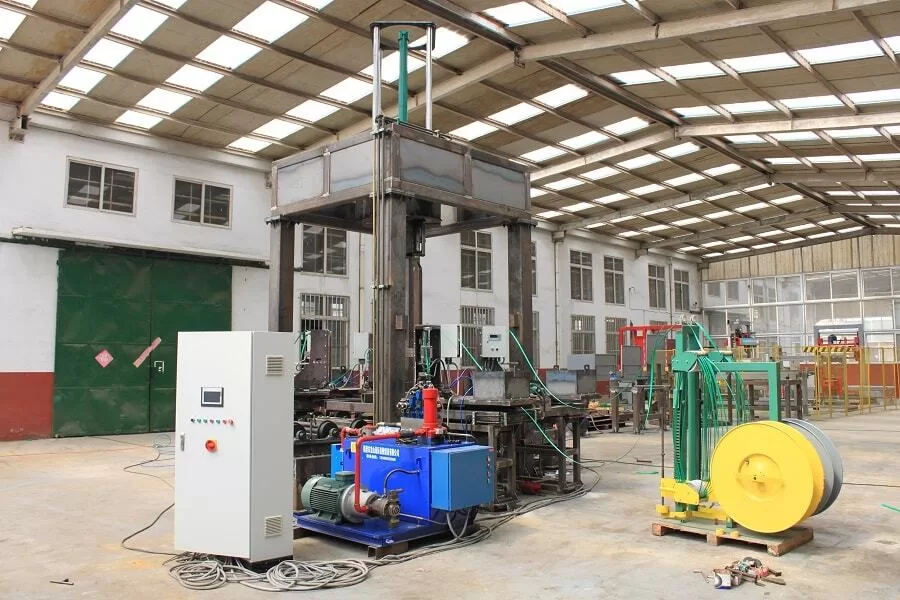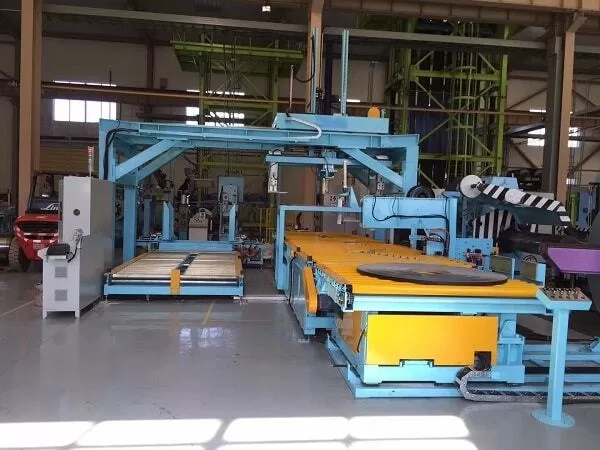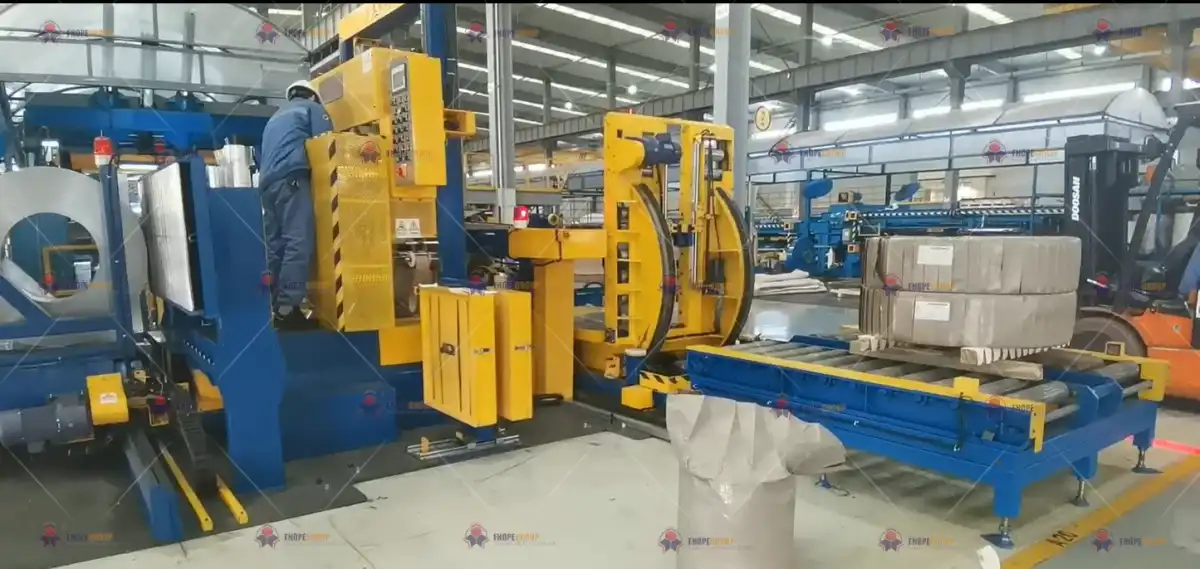Are you constantly analyzing the balance sheet? Do you see the rising costs of energy, labor, and maintenance eating into your profit margins? You know that your aging equipment is a ticking time bomb, leading to more frequent breakdowns and production halts. I understand this pressure. As an engineer who built a factory from the ground up, I’ve been there. You are looking for a solution that isn't just a new machine, but a strategic investment that delivers a clear, measurable return. You need a system that cuts costs, boosts efficiency, and prepares your plant for the future.
The best-selling coil packing systems in Brazil for 2025 are fully automated lines that integrate directly with your plant's MES and ERP systems. These systems focus on minimizing material consumption, maximizing throughput, and providing predictive maintenance data. This allows steel mills to achieve a significant return on investment (ROI) by drastically reducing operational costs and increasing uptime, directly addressing the industry's biggest challenges.

I have spent my entire career in the coil packing industry. I started on the factory floor and eventually built my own company, SHJLPACK. I have seen what works and what does not. The journey taught me that the right equipment is more than just steel and motors; it is a catalyst for growth. I have helped many clients, men and women running steel mills just like yours, transform their operations. They were facing the same challenges: volatile costs and aging infrastructure. Now, I want to share the insights I have gained. This is not about selling you a machine. This is about sharing knowledge. Let’s look at the trends shaping the Brazilian market. These trends offer a blueprint for any steel producer in Latin America looking for a competitive edge and a strong ROI.
How Can Automated Packing Lines Tackle Rising Labor Costs and Inefficiency?
Your team is skilled, but manual packing processes are inherently slow and prone to human error. You see inconsistencies in wrapping quality, which can lead to product damage during shipping. Worse, you worry about the safety risks of manually handling heavy coils. The constant need for manual intervention creates production bottlenecks, and with labor costs always on the rise, you know this model is not sustainable. You need a way to standardize your output, protect your people, and make your entire operation more efficient.
Automated coil packing lines directly solve these challenges by replacing manual labor with precise, consistent, and high-speed machinery. This reduces labor costs by up to 70% in the packing area. It also eliminates inconsistencies in packaging quality and significantly improves worker safety. The result is a streamlined process with higher throughput and fewer bottlenecks, directly boosting your plant's overall efficiency.

Dive Deeper: The Operational Impact of Automation
When we talk about automation, we are talking about a fundamental shift in how your packing station operates. It is not just about replacing people with machines. It is about redesigning the workflow for maximum efficiency, safety, and quality. Let's break down the real-world impact.
Reducing Manual Handling and Errors
In a traditional setup, operators manually guide coils, apply wrapping materials, and place labels. Each step is an opportunity for error. A poorly wrapped coil can unravel. A misplaced label can cause a major shipping mistake. I remember a client in São Paulo who was losing thousands of dollars a month due to moisture damage on coils during transit. The problem was inconsistent manual wrapping. After we installed an automated orbital wrapper, the issue disappeared entirely. The machine applies the exact same tension and overlap every single time. This level of consistency is impossible to achieve manually, especially across different shifts and operators. Automation removes the variable of human error from the equation.
Optimizing Material Usage
How much stretch film or VCI paper is wasted in your plant each month? In a manual process, operators often use more material than necessary "just to be safe." An automated system is programmed for optimization. It uses sensors to measure the coil's dimensions and applies the precise amount of material needed for secure packaging, and not a bit more. This can lead to a 15-20% reduction in consumable costs. For a large mill, this translates to huge annual savings. It is a direct and immediate contribution to your bottom line.
Here is a simple comparison of a manual versus an automated packing process:
| Feature | Manual Packing Process | Automated Packing Line |
|---|---|---|
| Throughput | 5-10 Coils/Hour (Varies) | 20-30 Coils/Hour (Consistent) |
| Labor Requirement | 2-3 Operators per Shift | 1 Supervisor for the Line |
| Material Waste | 10-25% Over-application | <5% Optimized Usage |
| Safety Risk | High (Lifting, Repetitive Motion) | Low (Operators are Supervisors) |
| Quality Control | Inconsistent | Highly Consistent |
| Data Tracking | Manual Logs (Often Inaccurate) | Automatic (Weight, Dimensions, Time) |
This table shows the clear advantages. Automation is not an expense; it is an investment in operational excellence that pays for itself. It addresses the core challenges of cost, safety, and quality control head-on.
What Integration Features are Key for a Truly "Smart" Packing System?
You have invested in high-level systems like an MES or ERP to manage your plant. But does your packing line talk to these systems? Often, the packing station is an information black hole. Production data is entered manually, if at all. This creates a disconnect between what is happening on the floor and what your management systems are reporting. You cannot make smart, data-driven decisions without accurate, real-time information. You need a packing system that is not just a standalone machine, but a fully integrated part of your digital ecosystem.
The key integration features for a "smart" packing system are seamless connectivity with MES/ERP platforms, IoT sensor implementation, and a user-friendly HMI. This allows for the automatic exchange of data, such as coil IDs, weight, and dimensions, eliminating manual entry. It also enables real-time monitoring and remote diagnostics, transforming the packing line into an intelligent data node within your Industry 4.0 strategy.

Dive Deeper: Building the Connected Packing Line
A "smart" packing system is the final piece of the puzzle in achieving total production visibility. When I work with clients on new projects, our conversation quickly moves beyond wrapping speeds. We discuss data. We talk about how the packing line can feed crucial information back into their central management systems. This is where the real value lies for a forward-thinking leader like you.
Seamless MES/ERP Communication
The foundation of a smart system is its ability to communicate. A modern packing line should be able to receive production orders directly from your MES. When a coil arrives at the packing station, a barcode scanner reads its ID. The system then queries your database for all relevant information: customer specifications, required wrapping material, and destination. There is no need for an operator to look up a work order or manually input data. Once the coil is packed, the system sends data back to the MES/ERP. This includes the final packed weight, materials consumed, and a timestamp. Your inventory is updated in real-time. Your sales team knows exactly when an order is ready to ship. This two-way communication eliminates data entry errors and provides a single source of truth for your entire operation.
The Power of IoT and Data Analytics
Integration goes beyond simple data exchange. We equip our machines with a suite of IoT sensors that monitor every aspect of performance.
- Vibration Sensors: These can detect early signs of wear in motors or bearings, allowing for predictive maintenance before a failure occurs. This is critical for achieving your 95% uptime goal.
- Power Consumption Meters: These track energy usage for each packing cycle. You can analyze this data to identify inefficiencies and work towards your goal of a 10% reduction in unit energy consumption.
- Material Sensors: These monitor the level of stretch film or paper on the spools, automatically alerting staff when a change is needed, preventing unnecessary downtime.
All this data is collected and visualized on a central dashboard. You can see your packing OEE (Overall Equipment Effectiveness) at a glance. You can track trends over time. This is how you move from a reactive maintenance model to a proactive, data-driven one. One of my clients used this data to discover that one specific type of coil was causing 30% more wear on the wrapper than any other. By adjusting the wrapping parameters for that product, they extended the machine's maintenance interval by six months. This is the kind of granular control that smart integration provides.
How Do Modern Systems Address Brazil's Tough Environmental Standards?
Governments everywhere, including in Brazil, are putting more pressure on heavy industry to be cleaner. You are facing stricter regulations on emissions and waste. This is not just a compliance issue; it is a financial one. Fines for non-compliance can be severe, and consumers are increasingly favoring sustainable suppliers. You are probably thinking about how any new equipment investment can help, not hinder, your environmental goals. The answer cannot be to simply add more cost; the solution needs to be smart and efficient.
Modern coil packing systems address environmental standards by focusing on two key areas: energy efficiency and material reduction. They use high-efficiency motors and regenerative braking systems to cut electricity consumption by up to 25%. They also use precise controls to minimize the use of packing materials like plastic film and VCI paper, directly reducing waste and supporting a plant's sustainability goals.

Dive Deeper: Engineering for Sustainability and Savings
When I started my career as an engineer, the focus was purely on speed and durability. Today, the conversation is different. Environmental performance is a core design principle. For a steel mill owner, this is great news. Why? Because green engineering almost always leads to lower operating costs. Helping the environment and helping your bottom line are not mutually exclusive goals.
Energy Consumption as a Design Focus
The biggest environmental and cost factor for any machine is energy. Old hydraulic systems were powerful, but notoriously inefficient. They ran constantly, consuming power even when the machine was idle. Modern packing lines are different.
- All-Electric Design: We have moved away from hydraulics to all-electric servo motors. These motors only draw significant power when they are moving. During idle times, their energy consumption is near zero. This change alone can reduce a machine's energy footprint by 50% or more compared to a 15-year-old hydraulic model.
- Regenerative Braking: When a large rotating ring on an orbital wrapper needs to slow down, it has a lot of momentum. In old designs, this energy was dissipated as heat using a brake resistor. It was just wasted energy. Modern systems use regenerative braking, similar to an electric car. The motor acts as a generator during deceleration, capturing that kinetic energy and feeding it back into the system. This can reduce overall electricity use by an additional 10-15%. This directly attacks the challenge of volatile energy costs.
Minimizing Waste Through Precision
Waste is both an environmental problem and a financial drain. Every meter of plastic film you throw away is money lost. Precision engineering is the answer.
Here’s how a modern system attacks material waste:
| Waste Reduction Method | Description | Estimated Savings |
|---|---|---|
| Pre-stretch Film Carriage | Stretches the film before application, increasing its yield. Can get up to 300% stretch. | 50-70% reduction in film volume |
| Automatic Cut & Clamp | Precisely cuts the film tail, eliminating long, wasteful tails left by manual cutting. | 5-10% material savings |
| Profile Following | Uses sensors to follow the coil's shape, ensuring even coverage without over-wrapping edges. | 5-10% material savings |
| Recipe Management | Stores the exact material parameters for each product type. Ensures consistent, optimized usage. | Eliminates operator guesswork and over-use |
By combining these technologies, you are not just buying a packing machine. You are investing in a waste reduction system. This helps you meet environmental regulations and cuts your consumable spending. It is a clear win-win.
What's the Real ROI on Upgrading to a 2025 Coil Packing System?
As a business owner, every investment decision comes down to one question: what is the return? You can see the benefits of automation, integration, and sustainability. But you need to justify the capital expenditure. You are looking at your aging equipment and weighing the cost of a new system against the ongoing costs of maintenance, downtime, and inefficiency. You need a clear picture of the financial payback to present to your board or to make the final call yourself.
The real ROI on upgrading to a 2025 coil packing system is a combination of direct cost savings and strategic gains, with a typical payback period of 18 to 36 months. The financial return is driven by reduced labor costs (up to 70%), lower material consumption (15-20%), and decreased energy use (25%+). Strategically, the ROI comes from increased throughput, higher product quality, and the ability to operate as a data-driven, Industry 4.0-ready facility.

Dive Deeper: Calculating the Full Return on Investment
Calculating the true ROI requires looking beyond the initial purchase price. It involves a holistic view of your operation, both now and in the future. I always encourage my clients to think in terms of Total Cost of Ownership (TCO) and strategic value. Let's break down the components of the ROI calculation.
Tangible, Hard-Cost Savings
These are the numbers you can easily track on your balance sheet. They are the most direct and immediate returns from your investment.
- Labor: This is often the biggest and fastest return. Let's say you currently have two operators per shift on your packing line, over three shifts. That's six operators. An automated line might only need one supervisor. The salary and benefit savings are substantial and immediate.
- Materials: As we discussed, a modern system with pre-stretch and precision controls can cut your film or paper consumption significantly. Calculate your current annual spending on these materials and apply a conservative 15% reduction. The number is often surprising.
- Energy: Get the power rating (kW) of your current machine and estimate its running hours. Compare that to the specifications of a new all-electric model. The difference, multiplied by your local electricity rate, gives you a clear energy saving figure.
- Maintenance & Downtime: This is a crucial one for aging equipment. How much did you spend on spare parts and emergency maintenance last year? How many hours of production did you lose due to breakdowns? A new machine comes with a warranty and, more importantly, with predictive maintenance capabilities that nearly eliminate unplanned downtime. This directly supports your goal of 95% capacity utilization.
Intangible, Strategic Gains
These benefits are harder to put a precise number on, but they are equally important for long-term success.
- Increased Throughput: If a new line can pack 25 coils per hour instead of your current 10, what does that mean? It means you can fulfill orders faster, reduce lead times, and potentially take on more business without expanding other parts of your plant.
- Improved Quality & Reputation: Zero damage claims due to poor packaging. Consistent, professional-looking products arriving at your customer's door. This builds your brand reputation and can be a deciding factor for customers choosing between you and a competitor.
- Future-Proofing Your Operation: By investing in a system that integrates with MES and IoT platforms, you are building the foundation for your digital transformation. You are preparing your factory for the next decade of industrial innovation. This strategic positioning is invaluable.
When you combine the hard savings with the strategic gains, the case for upgrading becomes very powerful. The investment stops looking like a cost and starts looking like what it is: a critical step toward a more profitable, efficient, and resilient future.
Conclusion
Investing in modern, automated coil packing is a direct path to higher ROI. It cuts costs, boosts efficiency, and prepares your facility for the future of manufacturing.





